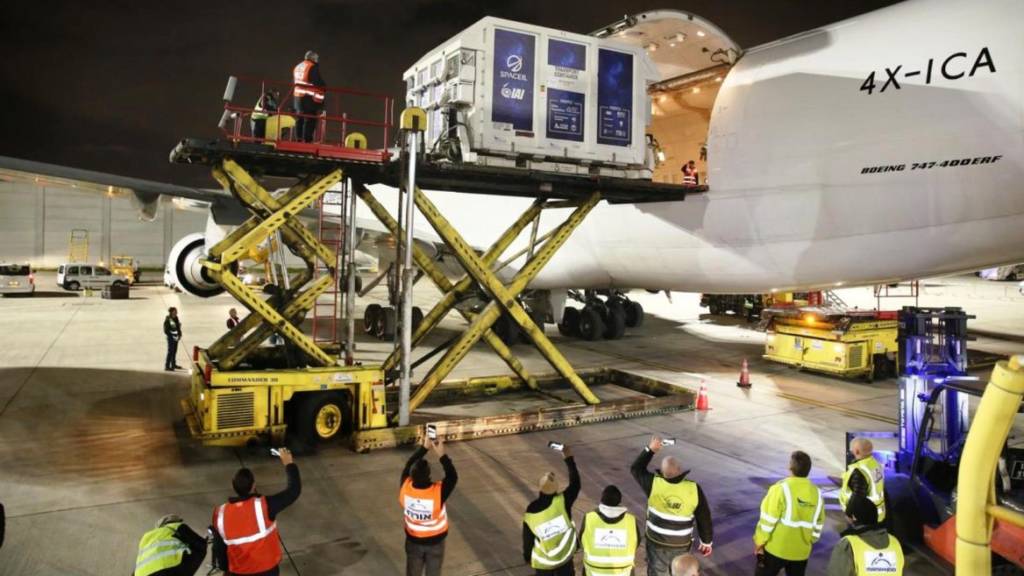With SpaceIL’s unmanned spacecraft set to lift off next week, the organization’s Science Team has included instruments that will help unlock the secrets of the Moon’s magnetic rocks.
By Abigail Klein Leichman, ISRAEL21c
After eight years of preparations costing $100 million, the SpaceIL Israeli unmanned spacecraft “Beresheet” (Genesis) is tentatively scheduled to take off from Cape Canaveral Air Force Station, Florida, on February 21 and reach the rocky surface of the moon six to eight weeks later following multiple orbits around Earth.
Prof. Oded Aharonson of the Weizmann Institute of Science’s Earth and Planetary Sciences Department hopes to be at the launch along with the other seven members of SpaceIL International Science Team he heads.
The team members – from Israel, France and the United States — put scientific instruments aboard Beresheet to take measurements that they hope will shed new light on one of the basic enigmas about the moon:
Although rocks collected by Apollo missions were found to be magnetic, the moon’s iron core does not generate a global magnetic field as does the Earth’s iron core.
“On Earth the rocks are magnetized from the global magnetic field, but how and when did the lunar rocks get magnetized? If we can measure the magnetism of these rocks, we can begin to understand how and when this magnetism arose,” Aharonson tells ISRAEL21c.
Scientists have various theories about how a temporary magnetic “dynamo” may have been generated on the Moon, perhaps from repeated asteroid impacts or from the long-ago dynamo action of the iron core that is now cool. But nobody knows how long that dynamo lasted.
“As we find younger and younger rocks – say 2 billion years old instead of 3 billion years old — that still have a magnetic signature, then we conclude the dynamo must have been alive for longer than previously hypothesized.
We’re motivated by this basic science question, to help us understand the universe around us,” says Aharonson, who earned his PhD at the Massachusetts Institute of Technology.
Magnetometer expert Asaf Grosz from Ben-Gurion University of the Negev’s department of electrical and computer engineering helped integrate a sensor built at UCLA onto the Beresheet spacecraft.
This instrument will be calibrated by measuring the magnetic field of the craft itself while it is still on its way. Once Beresheet is in orbit around the Moon, the instrument will be able to detect and measure the lunar magnetic field in different areas.
The craft also carries a unique array of mirrors provided by NASA for reflecting a laser beam of light precisely back in the direction of its source, a NASA Moon Orbiter (LRO), enabling the scientific team to track the position of Beresheet on the surface.
The landing site was chosen carefully by the scientific team to ensure a smooth and safe touchdown in a suitable area for performing the scientific experiments and relaying results back to Earth.
“We’ve had a lot of experience studying the surface of the moon including its topography and temperatures, so we synthesized all this information and narrowed it down to a dozen candidate landing sites without a lot of rocks and slopes, from which we selected the primary site to aim for,” says Aharonson. This area covers a few kilometers.
The Israeli spacecraft will be launched on a SpaceX Falcon 9 rocket. If it touches down successfully it will make Israel only the fourth country to land there after the US, the former Soviet Union and China.
SpaceIL is an independent initiative started in 2011 by Yariv Bash, Kfir Damari and Yonatan Winetraub to compete in the Google LunarX Prize competition. Although the competition officially ended in March 2018 with no winners, SpaceIL and its donors decided to continue working toward the goal of landing on the moon.
The 180-kilo Beresheet craft, built at Israel Aerospace Industries, was transported on January 17 in a cargo plane from Ben-Gurion Airport to Florida.
“After eight years of hard work, our dream has come true: We finally have a spacecraft,” said SpaceIL CEO Ido Anteby. “Shipping the spacecraft to the United States is the first stage of a complicated and historic journey to the moon. This is the first of many exciting moments, as we look forward to the forthcoming launch in Cape Canaveral.”
Do You Love Israel? Make a Donation - Show Your Support!
Donate to vital charities that help protect Israeli citizens and inspire millions around the world to support Israel too!
Now more than ever, Israel needs your help to fight and win the war -- including on the battlefield of public opinion.
Antisemitism, anti-Israel bias and boycotts are out of control. Israel's enemies are inciting terror and violence against innocent Israelis and Jews around the world. Help us fight back!
